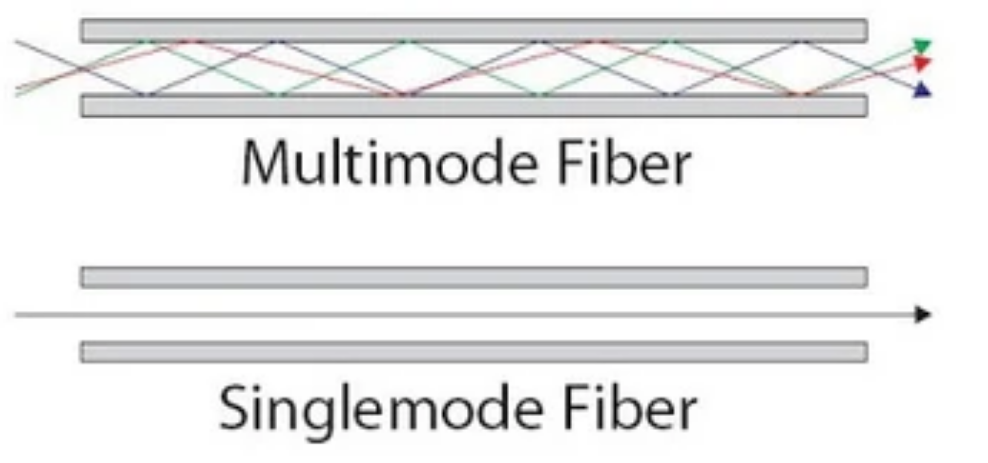Setting up the network infrastructure is a game of choice. You have a plethora of options when it comes to selecting the different materials in a network. You can either choose copper wire cables or fiber optic cables.
There is further bifurcation available in fiber optic types:
Single Mode Fiber Optic Cable and Multimode Fiber Optic Cable.
Choosing a suitable cable is vital as it has implications on the bandwidth, budget, and information travel distance. Hence it is essential to understanding the differences between both.

What are Single-mode and Multimode Fiber Optic?
First of all, in terms of working principle, both work by reflecting light multiple times in the glass core. However, the main difference between them lies in their structure. By definition, the working principle of a single-mode fiber optic cable is to transmit a single beam of focused light over a long distance. In contrast, a multimode fiber optic cable can simultaneously transmit multiple light sources within the same glass core.
Therefore, multiple molds have better bandwidth. However, this does not mean that multimode fiber is better than single mode fiber. Both have separate applications and are placed in the network infrastructure. Therefore, you cannot interchange them.
Let's delve into it to better understand their differences.
This is the difference between single-mode and multi-mode fiber optic cables
Difference #1 Structural difference
At first glance, there are no visual gifts for single-mode and multi-mode fibers. Cutting any cable will reveal a glass core covered with a protective cladding. The cladding allows bending to a certain extent. However, when comparing the two cables, you may notice that the multimode core wire is slightly thicker. Generally, a single-mode optical cable only needs to transmit one optical signal, and the core diameter is 9 µm. In contrast, multimode cables need to send many optical signals, and the core diameter is 62.3µm (OM1) or 50µm (OM2/OM3/OM4/OM5).
For clear identification, single-mode and multi-mode have different color protective covers. For example, a single-mode fiber optic cable has an orange PVC sheath.
The multimode optical cable has a light green PVC protective coating.
Difference #2 mode of operation
You may have learned about two properties of light in science class:
Reflection-A phenomenon in which light travels at the same angle (angle of reflection) as it hits the surface (angle of incidence).
Refraction-A phenomenon in which light rays deviate at an angle related to the angle of incidence.
Multimode fibers work according to the reflection characteristics of light. At the same time, single-mode fiber optic cables transmit optical signals in a nearly straight path.
Due to the constant reflection, the relative distance of propagation of multimode signals is smaller than that of single-mode fiber signals. In multimode fiber, the signal loss caused by fiber bending is very low. This is because the optical signal adjusts its path (to a certain extent) to bend radius. Because the core is thicker, multimode fibers can bend more without worrying about breakage. Therefore, single-mode fiber optic cables are more used for long-distance communications. Multimode is more suitable for cross-departmental or medium-sized enterprises.
Difference #3 modal dispersion
Modal dispersion is a phenomenon in which the propagation speed of different optical signals changes internally. This is due to the different reflection angles. Different speeds result in each optical signal arriving at different times. This phenomenon will cause signal distortion at the receiving end. This phenomenon often occurs in multimode fibers. Therefore, you need to repeat the signal after a certain length. The safety distance of the multimode fiber optic cable depends on the network frequency band. When 100BASE-FX is running, the signal needs to be repeated every 200m. For 40GB BASE SR4, OM3 multimode can experience modal dispersion when the length is> 100 meters.
Difference #4 light source
The light propagating in a single-mode fiber should be almost a straight path. Therefore, the light source is a laser or laser diode that emits finely polarized light with a wavelength of 1550 nm. In multimode fiber, we know that the core diameter is larger than that of single-mode fiber. Therefore, low-cost light sources such as LEDs that operate at wavelengths from 850nm to 1300nm are the best.
Difference #5 total cost
In terms of price, single-mode fiber optic cables are cheaper than multimode fibers of the same length. However, because the multi-mode core is larger, the cost of the transceiver at both ends of the multi-mode operation is lower. By purchasing pre-terminated multimode fiber optic cables, you can significantly reduce cable costs.
Difference #6 Facing the future
There are many different data bandwidth standards. You have separate multimode fiber optic cables that provide different bandwidth to distance ratios. For example, a single-mode fiber optic cable can transmit information up to 10 kilometers in a 10GBASE SE-SR network. However, it is ineffective for higher bandwidth. You can use multimode fiber optic cables for data bandwidth up to 100GBase SR10 networks, but distortion will affect the cable length. For example, OM1 and OM2 are sufficient for a 1GB Ethernet 1000BASE-LX network. For network bandwidth up to 100GBase SR10, you need OM3, OM4, or OM5 multimode fiber optic cables.
Therefore, when it comes to facing the future, multimode cables are more versatile. However, you should be aware of your network requirements to adapt to future expansion. As data rates increase, you either compromise on length or consider using expensive OM(x) (x=3,4,or5) cables.
Conclusion
You may have inferred that there are many differences between single-mode fiber optic cables and multi-mode fiber optic cables. Both provide durable data transmission with high bandwidth. However, understanding their advantages and limitations will allow you to make the right choice. When setting up a network, a system architect can help you plan a suitable network infrastructure. An infrastructure that meets your current needs and can be expanded in the future.

